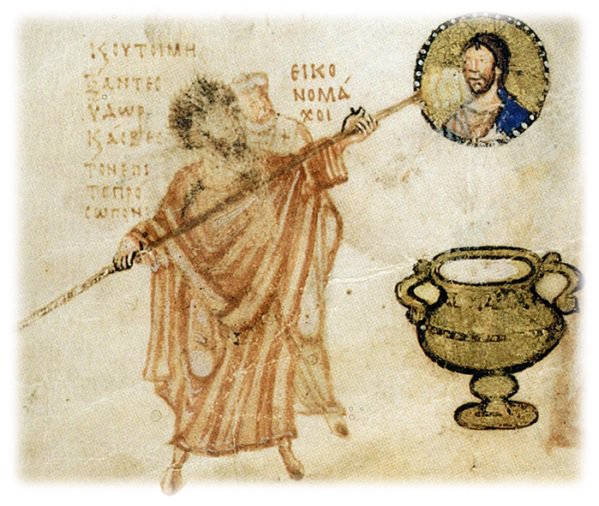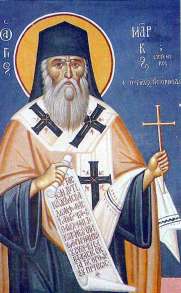Panteleimon Levakos, Theologian
The Repercussions of the Decisions of the Seventh Ecumenical Synod in the West
Последствия Решений VII Вселенского Собора на Западе
20 October 2018
Второй месяц церковного года связан с празднованием VII Вселенского Собора. Это был собор, которому предшествовали события, связанные с одним из самых жестоких вмешательств со стороны государства во внутренние дела Церкви. Иконоборческий спор был последней христологическим спором, * и он угрожал не только догматической, но и территориальной сплоченностью Империи, как на Востоке, так и на Западе. Собор был созван в Никее, Вифиния, в 787 году, с целью положить конец конфликту, догматически восстановить почитание, которое необходимо было воздавать святым иконам. В то же время, когда это происходило, византийцы на Западе столкнулись с устойчивым дипломатическим и военным экспансионизмом франков.
Экспансионизм франков проявлялся в том, что франкские политические силы вмешивались во внутренние дела Римской церкви, используя в качестве рычага тот факт, что Римский папа и Патриарх Константинопольский враждовали по вопросу о первенстве в Христианском мире. Мы попытаемся здесь уделять внимание не столько догматическому содержанию VII Вселенского Собора, сколько скорее обратить внимание на те последствия, которые оказали его решения на Запад, и вызвали реакцию короля франков, Карла Великого (царствовал 771-814), который выступил против этого Собора.
Иконоборческая борьба появилась в результате резкой политики Льва III Исаврянина (царствовал 717-741), который восстановил политическую стабильность в государстве. Вначале Лев решил провесьти широкую церковную реформацию, направленную на ограничение некоторых вызывающих, с его точки зрения, традиций членов Церкви, таких как использование икон в качестве крестных родителей, примешивать краски из икон и мощей святых для усиления силы Святого Причастия и т. д. Побочным эффектом этих литургических эксцессов был резкий упадок воинской повинности со стороны мужского населения, что выразилось в необыкновенном увеличении числа монахов в стенах Нового Рима. Желая ограничить эти экстремальные явления, Лев решил изолировать верующиъх от поклонения иконам, но при этом не налогался общий запрет на их почитание. Его первым актом в этом направлении было уничтожение чудотворной иконы ** Иисуса Христа, над Халкопрастийскими вратами, событие, которое вызвало возмущение среди населения.
Путь к решению догматической проблемы иконоборчества выдвинул на первый план конфликт между двумя главными предстоятелями церквей. В сотрудничестве с франкским политическим истеблишментом и в попытке воспользоваться иконоборческим спором Адриан I (772-795), епископ Рима, предпринял определенные инициативы, которые имели последствия для отношений между двумя Церквами. Используя тактические шаги, римский понтифик пытался подорвать престиж Константинопольского Патриархата. Осью раздора была претензия Патриарха Константинопольского на вселенскость. Эта проблема возникла, когда Тарасий (784-806) был избран на патриарший престол. Как обычно, новый патриарх посылал синодальные грамоты, подтверждающие его избрание в другие Церкви. Адриан ответил, что он категорически не согласен с титулом «Вселенский Патриарх», а также сделал намек на существование новых отношений между папским престолом и королевством франков.
Многогранная дипломатическая деятельность Карла Великого, короля франков, как на церковном, так и на политическом уровнях, была направлена на то, чтобы подорвать Византийскую империю и захватить в заложники Константинополь. В то время франкское истеблишмент считал, что политическая защита, которую он предоставил папскому престолу, дала ему право вмешиваться в церковные вопросы в Риме. Чтобы подтвердить это право, он отверг решения Седьмого Вселенского Собора в Никеи, заявив, что он не участвовал в его обсуждениях ***. И поэтому во Франкфурте был созван собор в 794г., так что франкские богословы ****, используя Libri Carolini(книги Каролингов), могли переоценить заново и отвергнуть решения Седьмого Вселенского Синода. Адриан не имел никакого отношения к демеру и поэтому согласился с формулировками франкских епископов.
Другим последствием конца первой фазы иконоборческого спора стало начало конфликта вокруг добавления «филиоке» к символу веры. Спустя двадцать лет после Седьмого Вселенского Собора Папа Лев III должен был обратит внимание на теорию, возникшую в богословских кругах франков, о том, что Святой Дух исходит от Отца и Сына. Этому противостояли как римские, так и греческие образованные слои в Вечном городе. Именно франкские / готические круги хотели ввести эту формулу в жизнь Римской церкви, и это было потому, что франкские богословы проводили от имени Карла Великого политическую и культурную кампанию против греко-римских христиан. В конце концов, Папа Лев III должен был запретить произнесение filioque франкскими епископами во время совершения мессы.
The second month of the Church’s year is linked to the celebration of the Seventh Ecumenical Synod. This was a synod which was accompanied by one of the most violent interventions by the State in the internal affairs of the Church. The iconoclast dispute was the last Christological quarrel* and threatened not only the dogmatic but also the territorial cohesion of the Empire, both in the East and in the West. The Synod was called in Nicaea, Bithynia, in 787, with the aim of putting an end to the conflict by dogmatically establishing the honour to be paid to the holy icons. At the same time as this was happening, the Byzantines in the West were facing sustained diplomatic and military expansionism by the Franks.

The expansionism of the Franks was expressed through the efforts of the Frankish political forces to interfere in the internal affairs of the Church of Rome, using as leverage the fact that the Pope of Rome and the Patriarch of Constantinople were generally at loggerheads over primacy within the Christian world. We shall attempt here to follow, not so much the dogmatic aspect of the Seventh Ecumenical Synod but rather the repercussions its decisions had in the West and the reaction of the King of the Franks, Charlemagne (reigned 771-814) against this Synod.
The iconoclast struggle was the result of the policy review by Leo III the Isaurian (reigned 717-741), who restored political stability to the state. As a start, Leo decided to put into place a broad ecclesiastical reformation aimed at restricting some of the extreme practices of members of the Church, such as the use of icons as godparents, the admixture of paint from icons and the relics of saints to reinforce the power of Holy Communion, and so on. A side-effect of these liturgical excesses was the avoidance of military conscription on the part of the male population, which was reflected in an impressive increase in the numbers of monks within the walls of New Rome. Wishing to restrict these extreme phenomena, Leo resolved to distance the faithful from the icons, but not to impose a general ban of paying them honour. His first act in this direction was the destruction of the wonder-working icon** of Jesus Christ, the Gainsayer, in the neighbourhood of the Copper Merchants, an event that caused outrage among the populace.
The road towards a solution of the dogmatic issue of iconoclasm brought to the fore the conflict between the two leading primates. In collaboration with the Frankish political establishment and in an attempt to exploit the iconoclast controversy, Hadrian I (772-795), the Bishop of Rome, took certain initiatives which had repercussions on the relations between the two Churches. Employing tactical moves, the Roman pontiff tried to undermine the prestige of the Patriarchate of Constantinople. The bone of contention was the claims of the Patriarch of Constantinople to ecumenicity. The opportunity arose when Tarasios (784-806) was elected to the patriarchal throne. As was customary, the new patriarch sent the synodal letters confirming his election to the other Churches. Hadrian replied that he directly challenged the title of ‘Ecumenical Patriarch’ and also hinted at a new relationship between the Papal throne and the kingdom of the Franks.

The multi-faceted diplomatic activity of Charlemagne, the King of the Franks, on both the ecclesiastical and political levels, was aimed at damaging the Byzantine Empire and taking the Church of Constantinople ‘hostage’. At that time, the Frankish establishment thought that the political protection it provided to the papal throne gave it the right to intervene in Church issues in Rome. In order to confirm this right, it cast aspersions on the decisions of the Seventh Ecumenical Synod of Nicaea, saying that it had not participated in its deliberations***. And so a council was called in Frankfurt, so that the Frankish theologians****, using the Libri Carolini (Carolingian Books) could rework the decisions of the Seventh Ecumenical Synod. Hadrian was in no position to demur and therefore went along with the formulations of the Frankish bishops.
Another side-effect of the end of the first phase of the iconoclast controversy was the start of the conflict over the addition of the ‘filioque’ to the Creed. Twenty years after the Seventh Ecumenical Synod, Pope Leo III had to address the theory, which arose from Frankish theological circles, that the Holy Spirit proceeds from the Father and the Son. This was opposed by both the Roman and Greek educated strata in the Eternal City. It was the Frankish/Gothic circles who wished to introduce this formula into the life of the Church of Rome and this was because the Frankish theologians were pursuing, on behalf of Charlemagne, a political and cultural campaign against the Greco-Roman Christians. In the end, Pope Leo III had to forbid the declaration of the filioque by Frankish bishops during the celebration of the Mass.

*Would that this were so. We need to be constantly vigilant in declaring that Christ was both God and human. Alterations to this position can slip in from the most apparently innocuous sources. On the Friday of Bright Week, we celebrate the feast of the Life-Receiving Spring, a feast of the Mother of God. In Greek, this is Ζωοδόχος Πηγή, which was, of course, correctly translated into Bulgarian as Живоприемни източник, Russian as Живоносный Источник, Serbian as Живопријемни источник. Somehow this has become, in English, the Life-Giving Spring. Christ is Life. He was begotten by His Father. For us humans, the Giver of Life is the Holy Spirit. So Life is associated with the three hypostases of God. Our Most Holy Lady, the Mother of God, received Life into her womb. There’s a danger that, if we talk about the Life-Giving Spring, we’re actually saying that Mary was simply the mother of Christ, since she clearly could not, on her own, have given birth to the pre-eternal God Who is without beginning [WJL].
** This phrase is a useful short-hand expression. At this time of the year, in October, the Dimitria Festival is held in Thessaloniki and one tradition is to bring a wonder-working icon of the Mother of God from another location to the church of Saint Dimitrios for a couple of weeks. Although this is popular, there is also some opposition to the practice from within the Church of Greece. Those opposed to it echo the views of Patriarch Tarasios, the chairman of the 7th Ecumenical Synod, who pointed out that there are no wonder-working icons. If a miracle is performed by an icon of, say, the Mother of God, this is because that particular icon has served as a channel or vehicle for the grace of Our Lady. After the event, we may wish to pay special honour to the icon because it served as a vehicle for grace and we may also hope that it will do so again, but we recognize that it’s not the icon itself that performed the miracle, just as we recognize that the depiction isn’t actually the Mother of God, though she may choose to reveal herself through it. This should be obvious in the case when a copy of a wonder-working icon on paper performs a miracle, even though many thousands of identical copies don’t. And even if they all did, it would still be the power of the person depicted that was active, not the piece of paper. [WJL].
*** Two (non-Frankish) papal legates were present, however, and signed the decrees.[WJL].
**** Alas, a tautology. The Germanic tribes of the Franks, Goths (Visi- and Ostro-) and Lombards, bless their hearts, are talented in many fields and have contributed much to Western civilization. Orthodox theology, however, seems to be beyond them. They were converted as Arians and appear never to have moved beyond that. They have, of course, produced a great many theologians, but to confuse quantity with quality is akin to misjudging forward motion as progress. [WJL].
http://pemptousia.com/2018/10/the-repercussions-of-the-decisions-of-the-seventh-ecumenical-synod-in-the-west/

